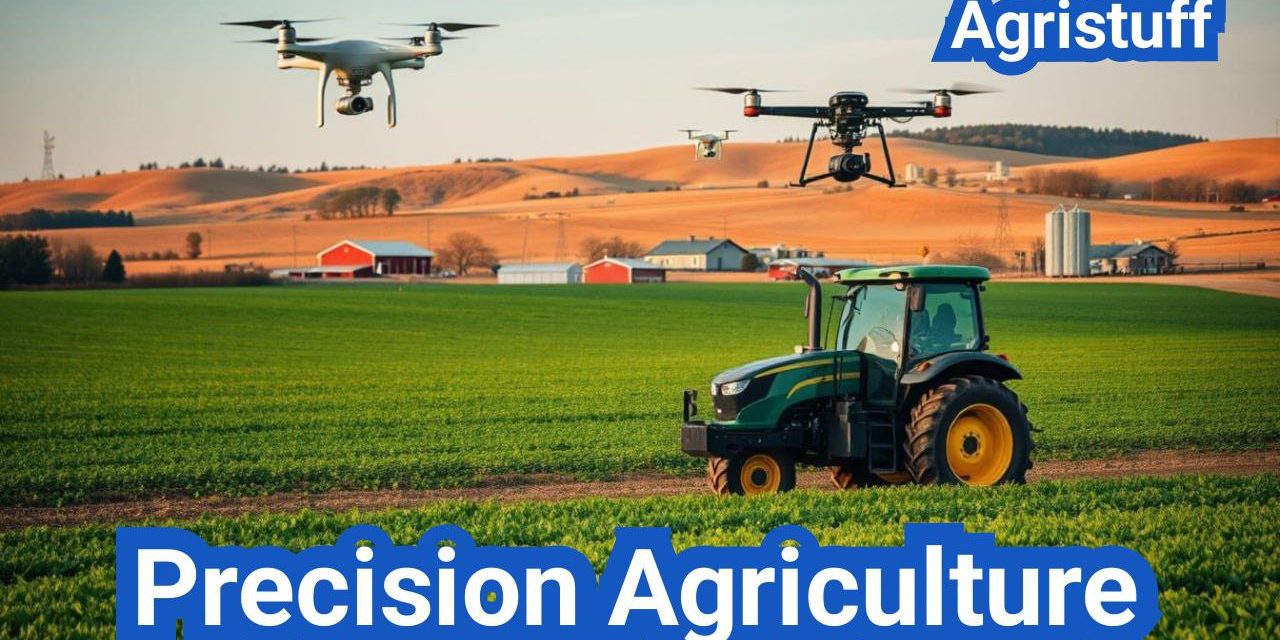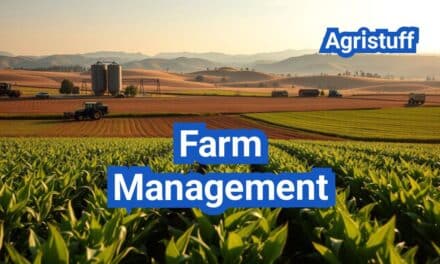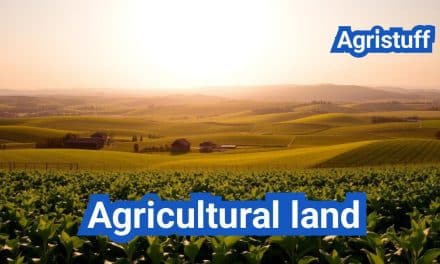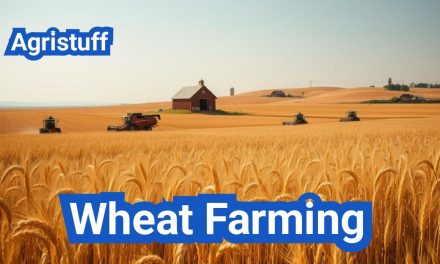Precision agriculture is revolutionizing the way crops are produced, leveraging advanced technology to optimize yields and reduce waste.
By utilizing sensors, GPS, and data analysis, farmers can make informed decisions, improving crop health and productivity. This approach is transforming the agricultural industry, enabling farmers to produce more with less.
The integration of technology in farming practices has given rise to smart farming and digital farming techniques, which are redefining the future of agriculture.
Key Takeaways
- Precision agriculture optimizes crop production using advanced technology.
- Key technologies include sensors, GPS, and data analysis.
- Smart farming and digital farming are emerging trends.
- Precision agriculture improves crop health and productivity.
- It enables farmers to produce more with less.
What is Precision Agriculture?
At its core, precision agriculture is about using modern technology to improve farming practices. This approach involves the use of advanced technologies such as satellite imagery, GPS, and field mapping to enhance crop quality and profitability.
Definition and Core Concepts
Precision agriculture, also known as precision farming or site-specific crop management, is an agricultural practice that uses technology to optimize crop yields and reduce waste. The core concept revolves around understanding and managing the variability within fields to make informed decisions.
The key elements of precision agriculture include:
- Data collection through various technologies like sensors and drones
- Analysis of the collected data to understand field variability
- Implementation of site-specific management practices
- Continuous monitoring and adjustment of farming strategies
Evolution of Precision Farming
The evolution of precision farming has been marked by significant technological advancements. From the early use of simple GPS systems to the current sophisticated satellite imaging and IoT technologies, precision agriculture has come a long way.
| Technology | Description | Impact on Farming |
|---|---|---|
| GPS and GIS | Global Positioning System and Geographic Information System for precise field mapping | Improved accuracy in planting, spraying, and harvesting |
| Remote Sensing | Use of satellites and drones for crop monitoring | Early detection of crop stress and disease |
| Variable Rate Technology (VRT) | Application of inputs at variable rates based on field conditions | Optimized use of fertilizers, pesticides, and irrigation |
As precision agriculture continues to evolve, it is becoming increasingly important for farmers to adopt these technologies to remain competitive and sustainable.
The Historical Development of Precision Agriculture

Precision agriculture, as we know it today, is the result of decades of technological advancements starting from the 1990s. This agricultural practice has evolved significantly, transforming the way farmers manage their crops and resources.
Early Beginnings
The concept of precision agriculture began to take shape in the early 1990s with the introduction of Global Positioning System (GPS) technology. GPS allowed farmers to accurately navigate their fields and collect data on soil conditions, moisture levels, and crop yields.
The early adoption of precision agriculture was driven by the need for more efficient farming practices. Farmers began using GPS-guided equipment to optimize crop planting, reduce waste, and improve yields.
| Year | Technological Advancement | Impact on Precision Agriculture |
|---|---|---|
| 1990 | Introduction of GPS technology | Enabled accurate navigation and data collection |
| 1995 | Development of Geographic Information Systems (GIS) | Allowed for spatial data analysis and mapping |
| 2000 | Adoption of variable rate technology (VRT) | Enabled farmers to apply inputs at varying rates |
Modern Transformation
The modern era of precision agriculture has been marked by significant advancements in technology, including the integration of Internet of Things (IoT) devices, drones, and advanced data analytics. These technologies have enabled farmers to collect and analyze vast amounts of data, making more informed decisions.
The use of precision agriculture equipment, such as GPS-guided tractors and sensor-enabled irrigation systems, has become increasingly prevalent. These technologies have improved the efficiency and productivity of farming operations, contributing to the growth and sustainability of the agricultural sector.
- Improved crop yields through data-driven farming practices
- Reduced environmental impact through optimized input application
- Enhanced decision-making capabilities through advanced data analytics
The historical development of precision agriculture has been a gradual process, driven by technological innovation and the need for more efficient and sustainable farming practices. As technology continues to evolve, we can expect precision agriculture to play an increasingly important role in meeting the world’s food production needs.
Key Principles of Site-Specific Crop Management
Site-specific crop management is revolutionizing the agricultural landscape by tailoring farming practices to the specific needs of different areas within a field. This approach is fundamental to precision agriculture, enabling farmers to optimize crop yields, reduce waste, and promote sustainability.
The effectiveness of site-specific crop management hinges on two primary principles: variability management and data-driven decision making. Understanding and implementing these principles is crucial for farmers looking to adopt precision agriculture techniques.
Variability Management
Variability management involves recognizing and addressing the differences within a field, such as variations in soil type, moisture levels, and crop health. By using advanced technologies like GPS and GIS, farmers can create detailed maps of their fields, identifying areas that require different management strategies.
- Soil Variability: Different soil types have unique nutrient profiles and water-holding capacities. Managing these variations is key to optimizing fertilizer application and irrigation.
- Crop Health: Monitoring crop health across a field helps in early detection of issues such as pest infestations or nutrient deficiencies, allowing for targeted interventions.
Data-Driven Decision Making
Data-driven decision making is at the heart of site-specific crop management. By collecting and analyzing data on various factors affecting crop growth, farmers can make informed decisions that enhance productivity and reduce environmental impact.
- Data Collection: Advanced sensors, drones, and satellite imagery are used to gather data on soil conditions, weather patterns, and crop status.
- Data Analysis: Sophisticated software analyzes the collected data, providing insights into optimal farming practices, such as the best times for planting, irrigating, and harvesting.
By embracing these principles, farmers can not only improve their crop yields and reduce costs but also contribute to a more sustainable agricultural system. The integration of agritech solutions into farming practices represents a significant step forward in achieving these goals.
Essential Technologies in Precision Agriculture

The backbone of precision agriculture lies in its use of advanced technologies like GPS, GIS, and remote sensing. These technologies work in tandem to provide farmers with the data and insights needed to optimize their farming practices.
GPS and GIS Systems in Farming
GPS (Global Positioning System) and GIS (Geographic Information System) are fundamental to precision agriculture. GPS allows for the precise location of farm equipment and the accurate mapping of fields, while GIS provides a platform for analyzing and interpreting the spatial data collected. Together, they enable farmers to make informed decisions about planting, irrigation, and harvesting.
GPS technology has revolutionized farming by allowing for the automation of many processes, reducing overlap, and improving accuracy. GIS, on the other hand, helps in managing and analyzing the complex data related to soil types, moisture levels, and crop health.
Remote Sensing Applications
Remote sensing involves collecting data about the Earth’s surface through aerial or satellite imagery. In precision agriculture, remote sensing is used to monitor crop health, detect issues such as pest infestations or water stress, and assess soil conditions. This information is critical for making timely interventions that can significantly impact crop yields.
Satellite imagery and drones equipped with sensors are commonly used for remote sensing. They provide high-resolution images that can be analyzed to identify variations within fields, allowing for targeted application of inputs like fertilizers and pesticides.
Variable Rate Technology (VRT)
Variable Rate Technology (VRT) is a precision agriculture technique that involves applying inputs at varying rates across a field, based on the specific needs of different areas. This is made possible by the integration of GPS, GIS, and remote sensing data. VRT can be used for a variety of applications, including seeding, fertilizing, and irrigating.
By applying inputs at the right rate and in the right place, farmers can reduce waste, lower costs, and minimize environmental impact. VRT is a key component of precision agriculture systems, enabling more efficient and sustainable farming practices.
Precision Agriculture Equipment Overview
The backbone of precision agriculture lies in its sophisticated equipment, including GPS-guided machinery and smart implements. This equipment is revolutionizing farming practices by enhancing efficiency, reducing waste, and improving crop yields.
GPS-Guided Machinery
GPS-guided machinery is a cornerstone of precision agriculture, enabling farmers to navigate their fields with centimeter-level accuracy. This technology allows for precise planting, spraying, and harvesting, reducing overlap and minimizing waste. For instance, John Deere’s GPS-guided tractors are equipped with advanced auto-guidance systems that ensure optimal row alignment and reduce operator fatigue.
Key benefits of GPS-guided machinery include:
- Improved accuracy in planting and harvesting
- Reduced input costs through minimized overlap
- Enhanced operator efficiency and reduced fatigue
Sensor Technologies
Sensor technologies play a vital role in precision agriculture by monitoring various parameters such as soil moisture, temperature, and crop health. These sensors provide real-time data that farmers can use to make informed decisions. For example, soil moisture sensors can help determine the optimal irrigation schedule, reducing water waste and ensuring crops receive the right amount of moisture.
The use of sensor technologies has been praised by agricultural experts:
“Sensor technologies are transforming the way we farm by providing critical insights into soil and crop conditions, enabling more precise and efficient farming practices.”
Smart Implements and Attachments
Smart implements and attachments are designed to work in tandem with GPS-guided machinery and sensor technologies. These implements can adjust their operation in real-time based on data received from sensors and GPS systems. Examples include variable rate seeders and fertilizer applicators that can adjust their output according to the specific needs of different areas within a field.
A comparison of traditional and precision agriculture equipment is shown in the table below:
| Feature | Traditional Equipment | Precision Agriculture Equipment |
|---|---|---|
| Guidance System | Manual or basic GPS | Advanced GPS with auto-guidance |
| Application Method | Uniform application | Variable rate application |
| Data Analysis | Limited or manual analysis | Real-time data analysis with sensors |
John Deere Precision Ag Solutions
John Deere’s Precision Ag Solutions are redefining the future of farming with technology and innovation. By integrating advanced equipment, sophisticated software, and seamless integration with existing farm systems, John Deere is at the forefront of precision agriculture.
Precision Ag Equipment
John Deere offers a range of precision agriculture equipment designed to enhance efficiency and productivity. Their equipment includes GPS-guided machinery and advanced sensor technologies that enable farmers to optimize crop yields and reduce waste.
Key Features of John Deere Precision Ag Equipment:
- GPS-guided tractors and harvesters for precise operation
- Advanced sensor technologies for real-time data collection
- Smart implements and attachments for optimized performance
Farm Management Software
Effective farm management is crucial for precision agriculture. John Deere’s Farm Management Software provides farmers with the tools needed to analyze data, make informed decisions, and manage their operations more efficiently.
“John Deere’s Farm Management Software has revolutionized how we manage our farm. It’s like having a personal agronomist at our fingertips.” – Farmer testimonial
Integration with Existing Farm Systems
One of the key advantages of John Deere’s Precision Ag Solutions is their ability to integrate with existing farm systems. This ensures a smooth transition to precision agriculture without the need for significant infrastructure changes.
Benefits of Integration:
- Enhanced data analysis and decision-making capabilities
- Improved operational efficiency through streamlined processes
- Better compatibility with existing equipment and software
By leveraging John Deere’s Precision Ag Solutions, farmers can not only improve their current operations but also position themselves for future success in the ever-evolving agricultural landscape.
IoT in Agriculture: The Connected Farm

The integration of IoT technology in agriculture is revolutionizing farming practices by creating connected farms. This transformation is largely driven by the need for more efficient and productive farming methods.
IoT in agriculture, often referred to as IoT4Ag, involves the use of various technologies to create a network of interconnected devices that can collect and exchange data. This data is then used to make informed decisions, optimize resources, and improve crop yields.
IoT4Ag Applications and Benefits
IoT4Ag has numerous applications in agriculture, including precision farming, livestock monitoring, and supply chain management. Some of the key benefits of IoT4Ag include:
- Increased efficiency through automation
- Improved crop yields through data-driven decision making
- Enhanced resource management through real-time monitoring
- Better livestock health monitoring
Sensor Networks and Data Collection
Sensor networks play a crucial role in IoT4Ag by providing real-time data on various parameters such as soil moisture, temperature, and crop health. This data is collected and transmitted to a central system for analysis.
The use of sensor networks enables farmers to monitor their fields more effectively, making it possible to respond quickly to any issues that may arise.
| Sensor Type | Parameter Measured | Application |
|---|---|---|
| Soil Moisture Sensors | Soil Moisture Levels | Irrigation Management |
| Temperature Sensors | Air and Soil Temperature | Crop Health Monitoring |
| Crop Health Sensors | Crop Health and Vigor | Precision Farming |
Real-time Monitoring Systems
Real-time monitoring systems are a key component of IoT4Ag, enabling farmers to keep track of their crops and livestock in real-time. This allows for quick response to any issues, reducing the risk of crop failure or livestock disease.
By leveraging IoT technology, farmers can create a more connected and efficient farm, leading to improved productivity and profitability.
Agricultural Drones and Their Applications

The integration of drones in agriculture has revolutionized farming practices, offering unprecedented precision and efficiency. Agricultural drones are being increasingly used for various applications, including crop monitoring, soil analysis, and crop spraying.
Types of Agricultural Drones
Agricultural drones come in various types, each designed for specific tasks. The most common types include:
- Fixed-wing drones: These drones are ideal for large-scale crop monitoring and are known for their endurance and range.
- Rotary-wing drones: More maneuverable than fixed-wing drones, rotary-wing drones are suitable for tasks that require hovering and precise movement.
- Hybrid drones: Combining the benefits of both fixed-wing and rotary-wing drones, hybrid drones offer versatility and are used for a variety of applications.
Drone Data Collection and Analysis
One of the key benefits of agricultural drones is their ability to collect and analyze data. Equipped with various sensors and cameras, drones can capture detailed images and data on crop health, growth, and development.
The data collected by drones is analyzed using specialized software to provide insights that can help farmers make informed decisions. Some of the data analysis applications include:
- Crop health monitoring: Identifying issues such as pest infestations, disease outbreaks, and nutrient deficiencies.
- Yield prediction: Estimating crop yields based on growth patterns and health.
- Soil analysis: Assessing soil moisture, temperature, and other factors that impact crop growth.
Regulatory Considerations
The use of agricultural drones is subject to various regulatory considerations. Farmers and drone operators must comply with rules set by aviation authorities, such as the Federal Aviation Administration (FAA) in the United States.
Some key regulatory considerations include:
- Drone registration: Registering drones with the relevant aviation authority.
- Flight restrictions: Adhering to restrictions on where and when drones can be flown.
- Operator certification: Ensuring that drone operators have the necessary training and certification.
By understanding and complying with these regulations, farmers can safely and effectively integrate drones into their agricultural practices.
Step-by-Step Guide to Precision Soil Management

Implementing precision soil management strategies can significantly improve farm productivity and sustainability. Precision soil management involves a series of steps that help farmers optimize soil conditions, reduce waste, and promote healthy crop growth.
Soil Sampling and Analysis
The first step in precision soil management is thorough soil sampling and analysis. This involves collecting soil samples from various parts of the field and analyzing them for nutrient content, pH levels, and other critical parameters. Advanced technologies like grid sampling and zone sampling can enhance the accuracy of soil data.
Creating Soil Management Zones
Once the soil data is collected and analyzed, the next step is to create soil management zones. These zones are delineated based on the variability of soil characteristics across the field. By managing the soil in these defined zones, farmers can apply targeted treatments, optimizing resource use and minimizing environmental impact.
Implementing Variable Rate Applications
Variable rate applications are a key component of precision soil management. This technique involves applying inputs such as fertilizers, lime, or irrigation water at varying rates across the field, based on the specific needs of each soil management zone. Variable Rate Technology (VRT) enables farmers to make data-driven decisions, reducing waste and improving crop yields.
Monitoring and Adjusting
The final step in precision soil management is continuous monitoring and adjustment. Farmers should regularly assess soil conditions and crop performance, making adjustments to their management strategies as needed. This might involve revising soil management zones, updating variable rate application maps, or incorporating new data from ongoing soil sampling.
By following these steps, farmers can implement effective precision soil management practices, enhancing the productivity and sustainability of their agricultural operations. Precision soil management is an integral part of broader precision agriculture systems, contributing to more efficient and environmentally friendly farming practices.
Mastering Precision Irrigation Management

Mastering precision irrigation management involves understanding and implementing advanced irrigation techniques that optimize water usage and enhance crop yields. This approach is crucial in modern agriculture, where water conservation and efficiency are paramount.
Step1: Water Requirement Assessment
Accurate water requirement assessment is the foundation of precision irrigation management. It involves analyzing various factors such as soil type, crop water needs, and weather conditions to determine the optimal amount of water required.
Soil moisture monitoring is a key aspect of this assessment, allowing farmers to make data-driven decisions about irrigation scheduling.
Step2: Irrigation System Selection and Setup
Selecting the right irrigation system is critical for effective precision irrigation management. Options include drip irrigation, sprinkler systems, and center pivot irrigation, each with its own advantages and suitability depending on the specific agricultural context.
The setup of the irrigation system must be carefully planned and executed to ensure uniform water distribution and minimize losses.
Step3: Implementing Smart Water Controls
Implementing smart water controls is a significant step in precision irrigation management. These controls utilize advanced technologies such as sensors and automation to regulate water flow based on real-time data.
“The integration of smart water controls has revolutionized irrigation management, enabling farmers to achieve higher levels of precision and efficiency.”
The use of IoT devices and data analytics further enhances the capability to monitor and adjust irrigation systems dynamically.
Step4: Data Analysis and System Optimization
The final step involves analyzing data collected from the irrigation system and making adjustments as necessary to optimize performance. This includes reviewing irrigation schedules, soil moisture levels, and crop responses to irrigation.
By leveraging data analytics platforms, farmers can gain insights into their irrigation operations and make informed decisions to improve water use efficiency and crop yields.
How to Implement Precision Agriculture on Your Farm

To successfully implement precision agriculture, farmers must first assess their specific needs and goals. This initial step is crucial in determining the most effective strategies and technologies to adopt.
Assessing Your Farm’s Needs and Goals
Assessing your farm’s needs involves evaluating current practices, identifying areas for improvement, and setting clear objectives. This process may include:
- Analyzing soil types and conditions
- Reviewing crop yields and historical data
- Identifying equipment and technology requirements
- Setting specific, measurable goals for productivity and sustainability
Selecting Appropriate Technologies
Once your farm’s needs are assessed, the next step is to select the appropriate precision agriculture technologies. This may include:
- GPS-guided machinery for precise planting and harvesting
- Remote sensing technologies for crop monitoring
- Variable Rate Technology (VRT) for optimized input application
- Farm management software for data analysis and decision-making
Creating an Implementation Timeline
Developing a detailed implementation timeline is essential for a smooth transition to precision agriculture. This timeline should include:
- Short-term goals, such as initial technology adoption
- Medium-term objectives, like integrating new equipment with existing systems
- Long-term plans for ongoing monitoring and evaluation
Training and System Integration
Effective implementation also requires comprehensive training for farm staff and integration of new technologies with existing systems. This involves:
- Providing training on new equipment and software
- Ensuring compatibility between different technologies
- Establishing protocols for data management and analysis
By following these steps and leveraging precision agriculture consulting services when needed, farmers can successfully implement precision agriculture practices on their farms.
Precision Agriculture Systems and Services

The adoption of precision agriculture systems and services is transforming the agricultural landscape by enhancing efficiency and productivity. These advanced systems and services are designed to optimize farm management, improve crop yields, and reduce waste.
Farm Management Information Systems
Farm Management Information Systems (FMIS) are crucial components of precision agriculture. These systems help farmers manage and analyze data related to their farming activities, including crop rotation, soil conditions, and equipment performance. By leveraging FMIS, farmers can make informed decisions that lead to improved crop yields and reduced costs.
Key features of FMIS include:
- Data collection and integration
- Field mapping and monitoring
- Yield analysis and forecasting
- Equipment tracking and management
Data Analytics Platforms
Data analytics platforms play a vital role in precision agriculture by providing farmers with actionable insights derived from their farm data. These platforms use advanced algorithms and machine learning techniques to analyze data from various sources, including sensors, drones, and satellite imagery.
The benefits of data analytics platforms include:
- Improved crop monitoring and management
- Enhanced decision-making capabilities
- Optimized resource allocation
- Predictive maintenance for equipment
Precision Agriculture Consulting Services
Precision agriculture consulting services offer expert guidance to farmers looking to implement precision agriculture technologies. These services help farmers assess their needs, select appropriate technologies, and integrate these technologies into their existing operations.
Consulting services can provide:
- Needs assessment and technology selection
- System integration and implementation
- Training and support
- Ongoing monitoring and optimization
By leveraging precision agriculture systems and services, farmers can significantly improve their operational efficiency, reduce environmental impact, and increase profitability. As the agricultural industry continues to evolve, the adoption of these advanced systems and services is expected to play a crucial role in shaping the future of farming.
Environmental Benefits of Sustainable Precision Farming

Sustainable precision farming is revolutionizing agriculture by providing numerous environmental benefits. By leveraging advanced technologies, farmers can optimize resource use, reduce waste, and promote eco-friendly practices.
Reduced Chemical Usage and Runoff
One of the significant environmental benefits of precision farming is the reduction in chemical usage and runoff. By using precision application techniques, farmers can apply fertilizers and pesticides more accurately, minimizing excess chemicals that can contaminate waterways.
Benefits of Reduced Chemical Usage:
- Minimized water pollution
- Reduced soil contamination
- Improved biodiversity
Water Conservation Strategies
Precision irrigation management is a crucial aspect of sustainable precision farming. By using advanced sensors and data analytics, farmers can optimize water usage, reducing waste and conserving this vital resource.
| Water Conservation Strategy | Description | Benefits |
|---|---|---|
| Drip Irrigation | Delivers water directly to the roots of plants | Reduces evaporation, runoff, and soil salinization |
| Precision Sprinkler Systems | Uses GPS and sensors to optimize water application | Minimizes water waste, reduces energy consumption |
| Soil Moisture Monitoring | Measures soil moisture levels to inform irrigation decisions | Prevents overwatering, reduces water consumption |
Soil Health Improvement and Carbon Sequestration
Precision farming practices also contribute to improved soil health and carbon sequestration. By optimizing tillage, crop rotation, and organic amendments, farmers can enhance soil fertility and structure, promoting carbon sequestration and mitigating climate change.
Soil health improvement is critical for maintaining ecosystem services, supporting biodiversity, and ensuring long-term agricultural productivity.
Biodiversity Enhancement
Finally, sustainable precision farming practices can enhance biodiversity by promoting ecosystem services and reducing the environmental impact of farming operations. By creating habitat corridors and conserving natural resources, farmers can support a diverse range of plant and animal species.
Biodiversity Benefits:
- Habitat creation and conservation
- Improved ecosystem services
- Enhanced ecosystem resilience
Economic Advantages of Precision Farming
The adoption of precision agriculture techniques has led to significant economic advantages for farmers. By leveraging advanced technologies such as GPS, GIS, and remote sensing, farmers can optimize their farming practices, leading to improved profitability.
Input Cost Reduction Strategies
One of the primary economic benefits of precision farming is the reduction in input costs. By using techniques such as variable rate application, farmers can minimize waste and ensure that resources like fertilizers and pesticides are used more efficiently.
Precision agriculture allows farmers to apply inputs only where they are needed, reducing overall costs. For example, variable rate fertilizer application ensures that fertilizers are applied in the right amount and in the right place, minimizing excess use.
Yield Optimization Techniques
Precision farming also enables farmers to optimize their yields through data-driven decision making. By analyzing data from various sources, including soil sensors and weather stations, farmers can make informed decisions about planting, irrigation, and harvesting.
Yield optimization is achieved through the use of advanced analytics and machine learning algorithms that help identify trends and patterns in crop performance. This enables farmers to take corrective actions to maximize their yields.
Long-term ROI Analysis
While the initial investment in precision agriculture technologies can be significant, the long-term return on investment (ROI) is substantial. By reducing input costs and optimizing yields, farmers can achieve significant cost savings and revenue increases over time.
A thorough ROI analysis should consider factors such as the cost of equipment, data analysis software, and training, as well as the potential returns from increased efficiency and productivity.
Access to New Markets and Premiums
Precision farming can also provide farmers with access to new markets and premiums. By adopting sustainable and traceable farming practices, farmers can differentiate their products and command higher prices.
For instance, crops grown using precision agriculture techniques can be marketed as sustainably produced, appealing to consumers who are willing to pay a premium for environmentally friendly products.
Real-World Examples of Successful Precision Agriculture Implementation
Farmers globally are witnessing the benefits of precision agriculture through numerous real-world success stories. These examples demonstrate how precision agriculture implementation can lead to improved efficiency, productivity, and sustainability in various farming operations.
Case Study1: Large-Scale Row Crop Farming
A notable example of successful precision agriculture implementation is in large-scale row crop farming. By utilizing GPS-guided machinery and variable rate technology, farmers have achieved significant reductions in input costs while maintaining or increasing yields. For instance, a farm in the Midwest implemented precision agriculture techniques, resulting in a 15% decrease in fertilizer application and a 10% increase in corn yields.
Case Study2: Specialty Crop Production
Precision agriculture has also proven beneficial in specialty crop production. Farmers growing high-value crops such as fruits and vegetables have adopted precision irrigation and crop monitoring systems. These technologies enable them to optimize water usage and detect potential issues early, leading to improved crop quality and reduced waste. A case study on a vineyard in California showed that precision irrigation management resulted in a 20% reduction in water consumption without compromising grape quality.
Case Study3: Livestock Management
The application of precision agriculture extends to livestock management as well. Farmers are using technologies like RFID tagging and sensor monitoring to track animal health and behavior. This data-driven approach allows for early detection of health issues and more efficient feeding strategies. A ranch in Texas implemented precision livestock management, achieving a 12% increase in cattle weight gain and a reduction in veterinary costs.
Case Study4: Small Farm Adoption
Precision agriculture is not limited to large-scale operations; small farms are also benefiting from these technologies. Small-scale farmers are adopting precision techniques such as soil sampling and variable rate application to improve their crop management. A small farm in Oregon used precision agriculture to optimize fertilizer application, resulting in a 25% reduction in costs and a significant improvement in soil health.
These case studies illustrate the diverse applications and benefits of precision agriculture across different farming operations. By embracing precision agriculture, farmers can achieve greater efficiency, productivity, and sustainability, contributing to a more resilient agricultural sector.
Finally: The Future of Precision Agriculture
The future of precision agriculture is promising, driven by ongoing advancements in technology and increasing adoption among farmers. As precision agriculture trends continue to evolve, we can expect to see further integration of precision agriculture technology, such as AI, IoT, and drones, into farming practices.
These innovations will enable farmers to make more informed decisions, optimize resource use, and improve crop yields. The potential for precision agriculture to transform the agricultural sector is vast, and its continued growth is expected to have a significant impact on the environment, economy, and food security.
As the agricultural industry continues to adopt precision agriculture practices, we can anticipate significant benefits, including reduced environmental impact, improved efficiency, and increased profitability for farmers. The future of precision agriculture is bright, and its development will be shaped by the ongoing advancements in precision agriculture technology.
FAQ
What is precision agriculture?
Precision agriculture is a farming management concept that uses technology and data analysis to optimize crop yields, reduce waste, and promote sustainable agricultural practices.
What are the benefits of precision agriculture?
The benefits of precision agriculture include increased crop yields, reduced input costs, improved resource allocation, and enhanced environmental sustainability.
What technologies are used in precision agriculture?
Precision agriculture utilizes various technologies, including GPS, GIS, remote sensing, drones, and IoT sensors, to collect and analyze data, making informed decisions, and optimizing farming practices.
How does precision agriculture help with soil management?
Precision agriculture helps with soil management by enabling farmers to create detailed soil maps, identify soil variability, and apply targeted fertilizers and amendments, reducing waste and promoting soil health.
What is site-specific crop management?
Site-specific crop management is an approach to farming that involves managing crops at the individual field or sub-field level, taking into account factors like soil type, moisture levels, and crop health, to optimize yields and reduce waste.
How does John Deere contribute to precision agriculture?
John Deere offers a range of precision agriculture solutions, including GPS-guided equipment, farm management software, and data analytics platforms, designed to help farmers optimize their operations and improve yields.
What is the role of IoT in precision agriculture?
IoT technology plays a crucial role in precision agriculture by enabling real-time monitoring and data collection, allowing farmers to make informed decisions, and optimize their farming practices.
How do agricultural drones support precision agriculture?
Agricultural drones equipped with sensors and cameras collect data on crop health, growth, and development, providing valuable insights for farmers to make data-driven decisions and optimize their farming practices.
What are the environmental benefits of precision agriculture?
Precision agriculture promotes environmental sustainability by reducing chemical usage, conserving water, improving soil health, and enhancing biodiversity, ultimately contributing to a more sustainable food system.
How can farmers implement precision agriculture on their farms?
Farmers can implement precision agriculture by assessing their farm’s needs, selecting appropriate technologies, creating an implementation timeline, and training personnel to ensure a smooth transition.
What are the economic advantages of precision farming?
Precision farming offers several economic advantages, including input cost reduction, yield optimization, and access to new markets and premiums, ultimately leading to increased profitability for farmers.
Conclusion of: Precision Agriculture
Precision agriculture is revolutionizing modern farming by combining data-driven insights with cutting-edge technology to enhance productivity, sustainability, and profitability. In the United States and globally, this approach to farming is rapidly gaining momentum. In this article, we’ll explore precision agriculture in-depth—covering its definition, how it works, the technology and equipment involved, and real-world examples of its implementation. Whether you’re a farmer, investor, or student, this guide offers everything you need to understand the impact and potential of precision agriculture today.
What Is Precision Agriculture?
Precision agriculture (also known as precision farming or smart farming) is a farming management concept that uses technology to monitor and optimize agricultural operations. By collecting and analyzing data on variables such as soil conditions, weather, crop health, and more, farmers can make smarter decisions that boost yield and reduce waste.
This method is driven by digital tools such as GPS, IoT sensors, AI, and data analytics. Instead of treating an entire field uniformly, precision agriculture allows farmers to treat specific sections based on real-time data.
🔗 Learn more from the USDA National Institute of Food and Agriculture
How Precision Agriculture Works
The core idea behind precision agriculture is to deliver the right input (such as water, fertilizer, pesticide) at the right time, in the right amount, and in the right place. This is achieved through technologies that collect and process data in real-time.
The steps typically include:
- Data Collection: Using drones, satellites, and field sensors.
- Data Analysis: Software and AI algorithms identify patterns.
- Decision Making: Actionable insights guide farm operations.
- Implementation: Machinery and equipment apply variable rates of input.
🔗 Read about the precision agriculture workflow at AgFunderNews
Key Technologies in Precision Agriculture
The success of precision agriculture depends on several advanced technologies, including:
- GPS and GIS: For mapping fields and tracking equipment.
- Remote Sensing: Through drones and satellites.
- IoT Devices: Soil moisture sensors, weather stations.
- Big Data & AI: Data processing and predictive analytics.
- Autonomous Machinery: Tractors and harvesters.
These technologies help in monitoring soil variability, weather forecasting, early detection of pests, and optimal irrigation.
🔗 Explore more technologies via AgriTech Tomorrow
Precision Agriculture Equipment
Modern precision agriculture relies heavily on smart equipment that can interpret and react to data inputs:
- Variable Rate Technology (VRT): Applies inputs like fertilizers in specific amounts based on location.
- Drones: For aerial imagery and crop health monitoring.
- Autonomous Tractors: GPS-guided tractors for planting and harvesting.
- Smart Irrigation Systems: Controlled by soil sensors and weather data.
- Yield Monitors: On harvesters to track crop productivity in real time.
Such equipment ensures resource-efficient farming, especially important in water-scarce regions of the U.S.
🔗 Check equipment trends from PrecisionAg Alliance
Benefits of Precision Agriculture
Precision agriculture brings several economic, environmental, and social advantages:
- Higher Yields: By tailoring inputs to field variability.
- Cost Savings: Efficient use of water, fuel, and fertilizers.
- Sustainability: Minimizing environmental impact.
- Labor Reduction: Through automation and remote monitoring.
- Risk Management: Predictive analytics help mitigate crop failure.
These benefits are particularly valuable in large-scale American farms that manage thousands of acres.
🔗 Explore benefits at American Society of Agronomy
Challenges Facing Precision Agriculture
Despite its promise, precision agriculture faces some challenges:
- High Initial Costs: Equipment and software are expensive.
- Data Management: Handling large volumes of data requires expertise.
- Connectivity Issues: Rural areas may lack strong internet.
- Technical Skills Gap: Farmers may need training in digital tools.
- Data Privacy Concerns: Who owns the data collected on farms?
Addressing these challenges is crucial for broader adoption, especially among small and medium-sized farms.
🔗 Read more on challenges from AgAmerica Lending
Examples of Precision Agriculture in Action
Across the U.S., farmers are already reaping the benefits of precision agriculture:
- Corn Belt (Midwest): Farmers use variable rate seeding and drone mapping for better corn yields.
- California Vineyards: Employ soil sensors and remote sensing to optimize irrigation.
- Texas Cotton Farms: Leverage satellite data and yield monitors for crop health tracking.
- Florida Citrus Groves: Use smart sprayers and pest detection systems.
These real-world examples show that precision agriculture is not just a theory—it’s changing the face of farming.
🔗 Find case studies at the International Society of Precision Agriculture (ISPA)
Environmental Impact of Precision Agriculture
Precision agriculture supports sustainable practices by minimizing overuse of fertilizers and chemicals, reducing water waste, and lowering emissions from machinery. It enables more regenerative farming by improving soil health through careful monitoring and optimized input.
This makes precision agriculture a key tool in fighting climate change and promoting ecological balance in U.S. agriculture.
🔗 Environmental benefits via EPA Agriculture Resources
Precision Agriculture in the U.S. Policy & Future Outlook
Government initiatives in the U.S. are actively supporting the growth of precision agriculture through research funding, educational programs, and smart farming incentives.
The future of precision agriculture involves even greater integration of AI, machine learning, and blockchain to ensure transparency and efficiency across the supply chain.
🔗 Check USDA’s initiatives on smart farming
Final Thought
Precision agriculture represents a vital leap forward for modern farming, offering enhanced yields, resource efficiency, and environmental responsibility. As technology continues to evolve, the integration of data and agriculture will become even more seamless. For U.S. farmers, agribusiness professionals, and policymakers, investing in precision agriculture means investing in the future of food security and sustainability.










